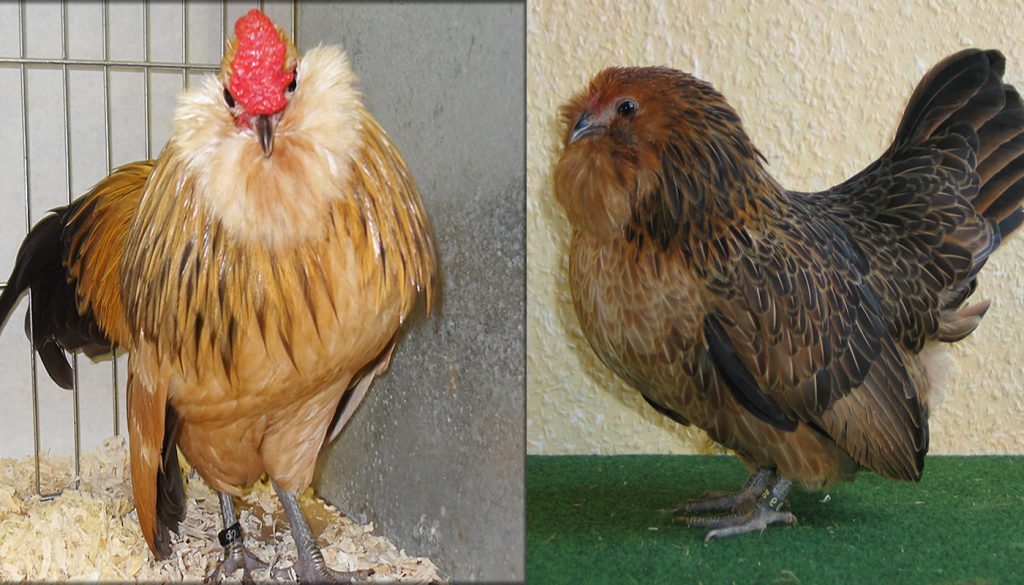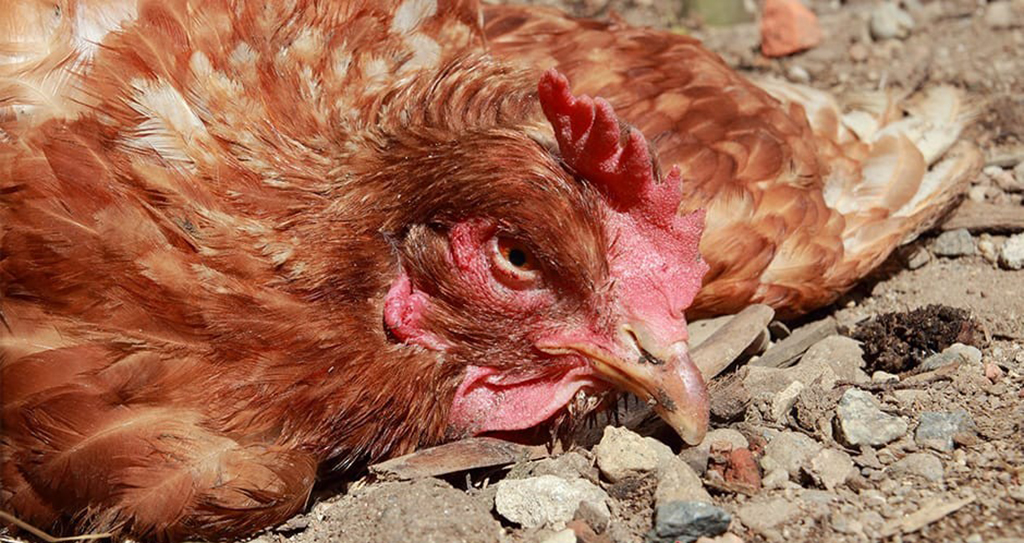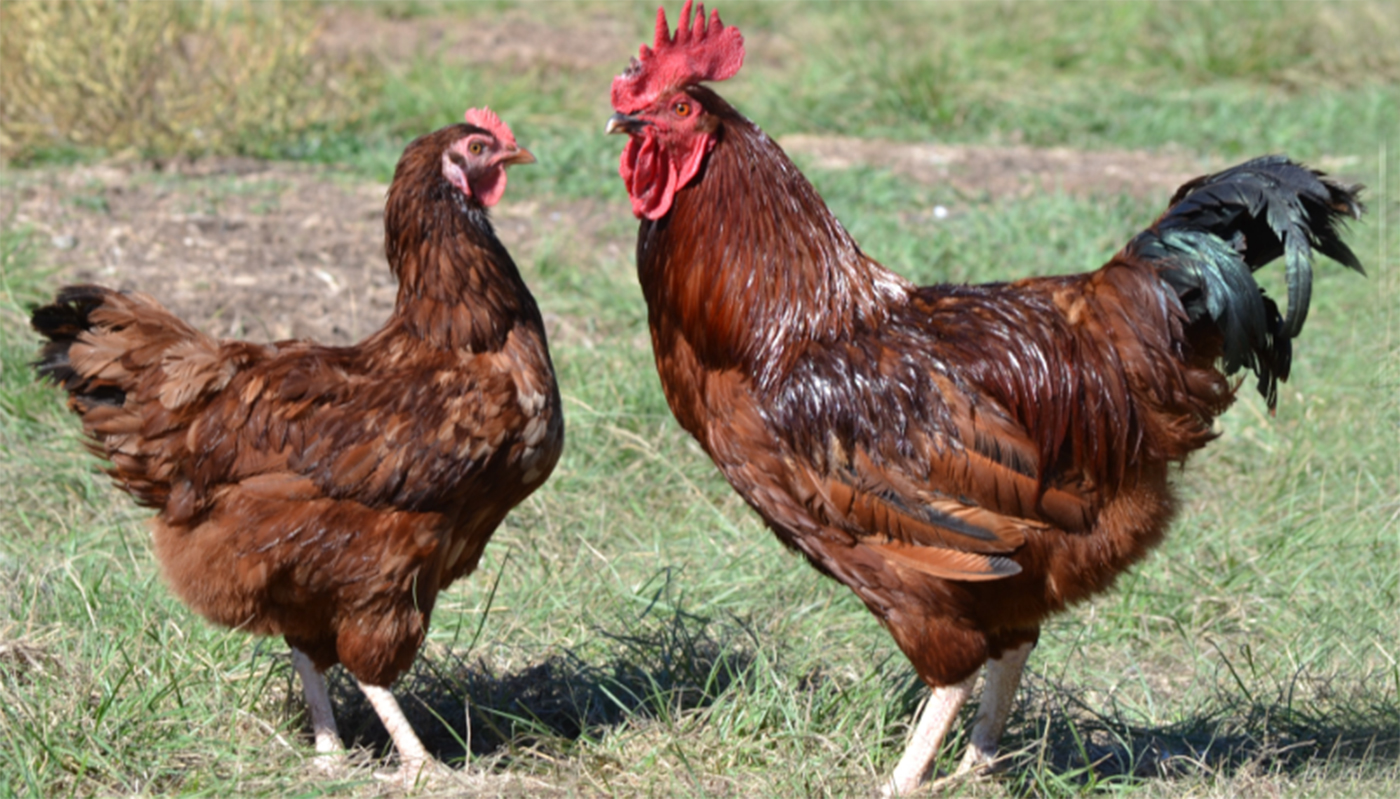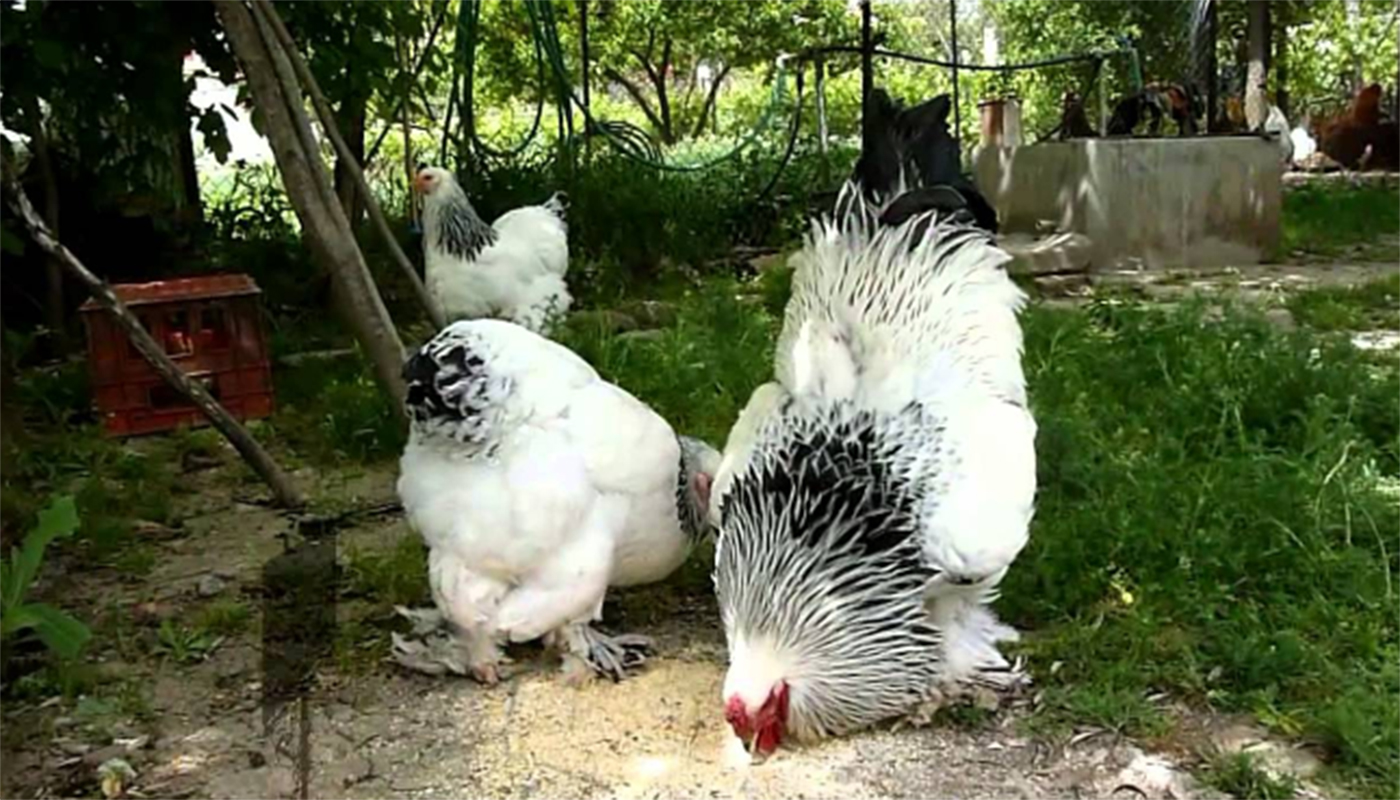
The Bearded D’Anvers Bantam do not have a standard size chicken variety and are true Bantams that have been around since the early to mid-1600’s.
These little chickens lay a lot of small white eggs and make great ornamental or show birds.
They originate from Belgium and although the rooster will try dominating the flock they are quite gently to humans. They are an excellent choice for a pet especially for children as they are gentle curious birds that will happily follow and play with a child.
Bearded D’anvers have proud regal bearing with a variety of colors, small to no wattles and their small flat earlobes, which are a bright red, are usually covered by muffs. This breed has a unique asymmetric body carrying its weight forward it stands tall and proud.
A chicken that is an excellent addition to any flock and as they are low maintenance are perfect as a started chicken.
| Country of Origin: | Belgium |
| American Poultry Association: | Recognized as a breed of chicken in the United States |
| Chicken Category: | Bantam |
| You may Also Like: | TOP 10 BANTAM CHICKEN BREEDS FOR BEGINNERS |
| Chicken Class: | Rose Comb Clean Legged |
| Bantam Variety Available? | There is only a Bantam breed |
| Good Starter Chicken? | They are a low maintenance chicken with a nature that makes them perfect as a starter chicken. |
| Related | 10 BEST STARTER CHICKENS FOR THE FIRST TIME POULTRY KEEPER |
PURPOSE⇒ |
Eggs: They are quite good steady consistent egg
layers. They will lay all year round. They lay small bantam sized eggs of white to a light brown color of up to 160 per year. They start to lay eggs from around 20 weeks old.
Meat: Not meant as a table/meat bird
Breeding: The hens are exceptionally brood and make great little brood hens.
Breeding the Bearded D’Anvers should be done under strict guidance of a registered or experienced breeder if a first-time breeder. This is especially true should the chickens be bred as show birds. For advice on breeding please check our guide to breed poultry. If you are a first-time breeder it is best to get professional advice from your local animal shelters, poultry farmers, breeding clubs, registered breeders or vet.
Foraging: These little chickens love to scratch and forage about. Their curious natures sometimes get them into a few tangles, so you will have to watch them around the garden.
Show Bird: They are show birds
Pets: They make wonderful pets
Other: Both the hens and roosters can be aggressive towards other chickens.
They will give your organic garden a lot of nutritious fertilizer to ensure great blooms and tasty vegetables. |
| Flyers? | Bearded D’Anvers are excellent flyers and love to fly so precautions have to be taken to stop them from flying the coop and garden. |
| Noisy Birds? | They are not too noisy but can get loud when aggressive. |
| Interaction with other chickens: | They can get aggressive the rooster loves to rule the roost and then hens tend to want to head up the pecking order. If not socialized correctly they could be quite disruptive. As with any flock if you are introducing new birds it is best to slowly socialize them with the flock. |
| Good with kids? | They are very easy to handle and are really good with children. |
| Related | 10 ROOSTER BREEDS THAT DO NOT MIND CHILDREN |
HISTORY
Bearded D’Anver Bantams are one of the only true Bantams that have been around since the 1600’s.
Where they are thought to have been present in Belgium and the Netherlands making them one of the oldest Bantam breeds. Although their ancestry is uncertain they are thought to have derived from the small bearded chickens that were found in the Low Countries.
They were known back then as the Belgium Antwerp.
There was a growing interest in the breed, in the 1800’s and by 1910 there were around five hundred members listed at the Club Avicole du Barbu Nain which was the breeders club for the Bearded D’Anver.
This breed is one of the only Belgian Bantam breeds that is not under threat of extinction or listed on any endangered species census.
The Belgian Bearded D’Anvers was admitted by the American Poultry Association to the Standard of Perfection in 1949.
It is also called the Barbu d’Anvers, Antwerpse baardkriel, Bearded d’Anvers, Antwerp Belgian.
CHARACTERISTICS |
|
|---|---|
IDENTIFICATION⇒ |
Appearance/Body: This little chicken has an upright stance, arched tail, rounded breast, small to no wattles and bright red earlobes that are usually completely covered by a fluffy beard or muffs.
Color(s) There are fourteen different colors recognized by the APA. These include porcelain, white, black, splash, blue, blue quail, quail, self-blue, mille fleur, buff, Colombian, Buff Colombian, mottled and cuckoo.
Comb: They have a rose comb
Ave. Weight: Pullet/Hens 20 oz/22 oz
Cockerel/Roosters 22 oz/26 oz |
| Life Expectancy: | The average lifespan is 6 – 8 years. |
| Health: | They do not mind the heat or the cold, so they tend to great in any climate. |
| You may Also Like: | HOW TO TELL IS A CHICKEN IS SICK |
| Temperament: | Can be a bit aggressive at times but are friendly curious birds that are very easy to handle. |
| Socialize Behavior? | They will ignore most domestic animals or be a bit skittish around them. |
| You may Also Like: | HOW TO SOCIALIZING YOUR NEW CHICKENS |
| Known predators: | As they are small breed it best to keep an eye on dogs and cats. If hawks and or foxes are in your area it is always best to take precautions. Check with local animal shelters, zoos, vets, animal control and or pet stores about common predators in your area. |
| Conservation Status: | They are not on any conservation watch list and area popular bird with most Bantam Breeders. To check on the conservation status of any domestic animal the information can be found on the conservation centers website. |
IDEAL ENVIRONMENT |
|
|---|---|
| Garden Size: | Bearded D’Anvers will adapt to confinement but prefer to be out and about. They may be smaller than most chickens, but they love the same amount of room to free-range in as normal sized chickens. |
| Ideal Climate: | The thrive in both the heat and cold as they are hardly little chooks. |
| Ideal Coop: | The rule of thumb for any coop is 50 cm x 50 cm per hen/rooster in the coop. Ensure there is a good space for the nesting boxes and nightly roosting rails at least 1.5 inches wide. Good ventilation for air but not too drafty especially in winter. It is always a good idea to raise the coop off the ground to give the birds a dry place to roost and lay especially in wet weather. |
| Ideal Coop Run: | As they are smaller than normal chickens and excellent flyers it is best to completely cover the coop run or they become an easy target for predators such as hawks. |
| Ideal Flock Size: | These little chickens do like a bigger flock to mingle with. It is advisable to have three or more of them. |
| Special Instructions: | They have not special grooming requirements and as they do not have many health issues are basically a low maintenance bird. |
| Accessories: | The following accessories are ideal for your coop: Nesting boxes Straw for the boxes and roosting area Roosting rails Perches Water troughs/bowls Food bowls/feeders Heating lamp(s) Animal carrier for transport purposes |
| You may Also Like: | 45 FREE DIY CHICKEN COOP PLANS, TUTORIALS AND DESIGNS |
WHERE TO FIND THESE BIRDS TO ADD TO YOUR FLOCK
Bearded D’Anvers can be found at most live poultry outlets and farms. If they are being kept as a show bird or for breeding purposes, then it is best to check with the various breeding clubs such as the Belgian Bearded D’Anvers Club of America for a registered breeder. There is a host of information about these Bantams on this website for owners of the breed.
They will also be able to help with any special requirements, attention or care they may need.
CARING FOR THE BIRD(S)
Please click here for our full guide to “Taking care of chickens”. This is a comprehensive guide to owning chickens. It covers where to start from choosing your ideal flock, the coop that would best suit your garden, your bird and you to buying and bringing your bird(s) home.
GENERAL
These proud regal little chooks are lively and inquisitive making an excellent addition to any flock.
They make a big impression for small chickens and love to rule over the roost.
GROOMING
As they are easy to handle regularly check them for mites, lice and various other parasites is quite easy and should be done at least once a week. They love dust baths so at least one well-positioned dust bath is a must. Always get your birds de-wormed on a regular basis especially if they are around other animals or interacting with kids.
DIET AND NUTRITION
Bearded D’Anvers love to forage and peck out the pests in the garden. Treats of mealworms and table scraps in the form of various fruits and vegetables are a welcome bonus to them. As with other chickens, they will eat chicken pellets, grains, chicken mash or grain mix from 8 weeks old and older. Their regular feed should always be fed to them before they are let out of their coop or run for the day.
For baby chickens, the best is always Chick Starter when they are under 8 weeks old.
Laying hens should get extra protein and calcium in their diets to ensure the quality of their eggs and to keep them in tip-top health.
Please see our comprehensive guide to “Feeding your chickens” for more information of the different types of chicken feed for chicks, hens, laying hens, roosters, etc. and where to buy the feed and approximate cost of the feed.
SOCIALIZING THE BIRD(S)
The Bearded D’Anvers may be small but they are mighty when it comes to wanting to be the king and queen of the flock. They can be quite aggressive and cheeky to other chicken’s extra care is needed when either introducing them to your current flock or introducing new chickens to your already established Bearded D’Anvers flock.
Always check on how well a breed will get on with your current flock before buying them as you do not want to upset your coop or stress your current flock.
As with any newcomer to the roost, you will have to quarantine the bird for 7 – 31 days to ensure it does not have any unwanted critters or disease that could spread to your current flock.
These birds can be quite disruptive when their pecking order is threatened it may take a little longer for them to accept newcomers to their flock.
NOTES / SPECIAL INSTRUCTIONS
Joining the various clubs that are associated with the breed(s) you have in your flock is a food idea. There is always events, shows and really good tips and advice to be had from fellow owners. For advice on what the bird’s conservation status and orders are please check with your local conservation department.
For breeders, it is imperative that you always check your bird’s bloodlines and ensure you are buying your birds from a reputed breeder/farm. In order to sell birds of such stature, they have to be recorded and documented, always check with local animal breeding organizations for these records.
These legitimate documents are also required should you wish to show your bird(s) in various poultry shows/competition showings.
For information and advice on adopting rescued animals, you can visit or contact your local animal welfare center.
Video
USEFUL LINKS
- Caring for your Chicken
- Feeding
- Health
- Socializing your Chicken
- Breeding Chicken
- Raising Chickens A-Z
- Hatching Eggs
- What is Molting
- Animal Shelter (ASPCA)
- American Veterinary Medical Association
- American Poultry Association
- American Animal Welfare Society
- American Animal Control
- American Animal Husbandry Society
References
- https://en.wikipedia.org
- https://livestockconservancy.org
- https://www.roysfarm.com
- https://www.mypetchicken.com
- https://www.backyardchickens.com
- https://www.feathersite.com/
 CHOOSING YOUR FERTILIZED EGG(S) – HATCHING EGGS PART 2
CHOOSING YOUR FERTILIZED EGG(S) – HATCHING EGGS PART 2 Conditions that can affect a Chicken Respiratory System
Conditions that can affect a Chicken Respiratory System La Fleche Chicken Breed – Everything You Need to Know
La Fleche Chicken Breed – Everything You Need to Know TO HATCH OR NOT TO HATCH? – HATCHING EGGS PART 1
TO HATCH OR NOT TO HATCH? – HATCHING EGGS PART 1 Yokohama Chicken Breed – Everything You Need to Know
Yokohama Chicken Breed – Everything You Need to Know Rhode Island Red Chicken Breed – Everything You Need to Know
Rhode Island Red Chicken Breed – Everything You Need to Know Frizzle Chicken Breed – Everything You Need to Know
Frizzle Chicken Breed – Everything You Need to Know Onagadori Chicken Breed – Everything You Need to Know
Onagadori Chicken Breed – Everything You Need to Know Barnevelder Chicken Breed – Everything You Need to Know
Barnevelder Chicken Breed – Everything You Need to Know The Top Chicken Breeds for Egg Laying
The Top Chicken Breeds for Egg Laying 10 Chicken Breeds that do well among other Chicken Breeds for a Mixed Flock
10 Chicken Breeds that do well among other Chicken Breeds for a Mixed Flock 10 Rooster Breeds that do not mind Children
10 Rooster Breeds that do not mind Children